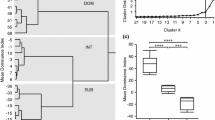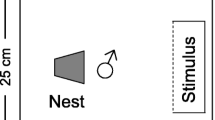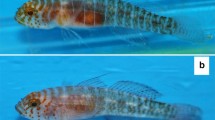Abstract
Sex change in marine teleost fishes is commonly regulated by social factors. In species that exhibit protogynous sex change, such as the bluebanded goby Lythrypnus dalli, the most dominant female typically initiates sex change when a male is removed from the social group. Females can use visual, chemical or tactile cues to assess the presence or absence of a male. The primary goal of our study was to determine whether the olfactory and visual presence of a male versus its behavioural interactions with females were important for mediating sex change. We exposed females to three different treatments: absence of a male, presence of a male that could physically interact with her and presence of a male behind a barrier that allowed visual and olfactory interactions but prohibited physical interactions. Sex change occurred in the absence of a male but not in the presence of a male that could physically interact with the female. The presence of a male behind the barrier did not prevent sex change but affected the timing of sex change. Season appeared to affect the latency to initiate male typical courtship, with a delay at the end of the reproductive season only when the male was present behind the barrier. We discuss the seasonal results in terms of L. dalli life history and the potential benefits and costs of changing sex late in the season in the presence or absence of aggressive reinforcement by the male. Our results identify direct behavioural interactions as an important proximate mechanism in the social regulation of sex change in L. dalli.


Similar content being viewed by others
References
Baeza JA, Bauer RT (2004) Experimental test of socially mediated sex change in a protrandic simultaneous hermaphrodite, the marine shrimp Lysmata wurdemanni (Caridea: Hippolytidae). Behav Ecol Sociobiol 55:544–550
Behrents KC (1983) The comparative ecology and interactions between two sympatric gobies (Lythrypnus dalli and Lythrypnus zebra). Ph.D. thesis, University of Southern California
Black MP, Moore B, Canario AVM, Ford D, Reavis R, Grober MS (2005) Reproduction in context: field testing a lab model of socially controlled sex change in Lythrypnus dalli (Gilbert). J Exp Mar Biol Ecol 318:127–143
Borowsky RL (1987) Agonistic behavior and social inhibition of maturation in fishes of the genus Xiphophorus (Poeciliidae). Copeia 3:792–796
Carlisle SL, Marxer-Miller SK, Canario AVM, Oliveira RF, Carneiro L, Grober MS (2000) Effects of 11-ketotestosterone on genital papilla morphology in the sex changing fish Lythrypnus dalli. J Fish Biol 57:445–456
Clarke FM, Faulkes CG (2001) Intracolony aggression in the eusocial naked mole-rat, Heterocephalus glaber. Anim Behav 61:311–324
Cole KS, Shapiro DY (1995) Social facilitation and sensory mediation of adult sex change in a cryptic, benthic marine goby. J Exp Mar Biol Ecol 186:65–75
Creel S, Creel N, Wildt DE, Monfort SL (1992) Behavioural and endocrine mechanisms of reproductive suppression in Serengeti dwarf mongooses. Anim Behav 43:231–245
Drilling CC, Grober MS (2005) An initial description of alternative male reproductive phenotypes in the bluebanded goby, Lythrypnus dalli (Teleostei, Gobiidae). Environ Biol Fishes 72:361–372
Ellis L (1995) Dominance and reproductive success among nonhuman animals: a cross-species comparison. Ethol Sociobiol 16:257–333
Fishelson L (1970) Protogynous sex reversal in the fish Anthias squamipinnis (Teleostei, Anthiidae) regulated by the presence or absence of a male fish. Nature 227:90–91
Francis RC, Soma K, Fernald RD (1993) Social regulation of the brain–pituitary–gonadal axis. Proc Natl Acad Sci U S A 90:7794–7798
Fricke H, Fricke S (1977) Monogamy and sex change by aggressive dominance in coral reef fish. Nature 266:830–832
Hacklander K, Mostl E, Arnold W (2003) Reproductive suppression in female alpine marmots, Marmota marmota. Anim Behav 65:1133–1140
Hartney K B, Grorud K A (2002) The effect of sea urchins as biogenic structures on the local abundance of a temperate reef fish. Oecologia 131:506–513
Keller L, Nonacs P (1993) The role of queen pheromones in social insects: queen control or queen signal? Anim Behav 45:787–794
Lutnesky MM (1994) Density-dependent protogynous sex change in territorial–haremic fishes: models and evidence. Behav Ecol 5:375–383
Marconato A, Rasotto MB, Mazzoldi C (1996) On the mechanism of sperm release in three gobiid fishes (Teleostei: Gobiidae). Environ Biol Fishes 46:321–327
Munoz RC, Warner RR (2003) A new version of the size-advantage hypothesis for sex change: incorporating sperm competition and size fecundity skew. Am Nat 161:749–761
Perry AN, Grober MS (2003) A model for social control of sex change: interactions of behavior, neuropeptides, glucocorticoids, and sex steroids. Horm Behav 43:31–38
Platt TG, Queller DC, Strassmann JE (2004) Aggression and worker control of caste fate in a multiple-queen wasp, Parachartergus colobopterus. Anim Behav 67:1–10
Reavis RH, Grober MS (1999) An integrative approach to sex change: social, behavioural and neurochemical changes in Lythrypnus dalli (Pisces). Acta Ethol 2:51–60
Robertson DR (1972) Social control of sex reversal in a coral-reef fish. Science 177:1007–1009
Rodgers EW, Drane S, Grober MS (2005) Sex reversal in Pairs of Lythrypnus dalli: behavioral and morphological changes. Biol Bull 208:120–126
Ross RM (1981) Experimental evidence for stimulation and inhibition of sex change in the Hawaiian reef fish Thalassoma duperrey. Proc 4th Int Coral Reef Symp 2:575–580
Ross RM, Losey GS, Diamond M (1983) Sex change in a coral-reef fish: dependence of stimulation and inhibition on relative size. Science 221:574–575
Scaggiante M, Mazzoldi C, Petersen CW, Rasotto MB (1999) Sperm competition and mode of fertilization in the grass goby Zosterisessor ophiocephalus (Teleostei: Gobiidae). J Exp Zool 283:81–90
Shapiro DY (1979) Social behavior, group structure and the control of sex reversal in hermaphroditic fish. Adv Study Behav 10:43–102
Shapiro DY (1981a) Intragroup behavioural changes and the initiation of sex reversal in a coral reef fish in the laboratory. Anim Behav 29:1199–1212
Shapiro DY (1981b) Size, maturation and the social control of sex reversal in the coral reef fish Anthias squamipinnis. J Zool Lond 193:105–128
Shapiro DY (1983) Distinguishing behavioral interactions from visual cues as causes of adult sex change in a coral reef fish. Horm Behav 17:424–432
St. Mary CM (1993) Novel sexual patterns in two simultaneously hermaphroditic gobies Lythrypnus dalli and Lythrypnus zebra. Copeia 4:1062–1072
St. Mary CM (1994) Sex allocation in a simultaneous hermaphrodite the blue-banded goby (Lythrypnus dalli): the effects of body size and behavioral gender and the consequences for reproduction. Behav Ecol 5:304–313
Visscher PK, Dukas R (1995) Honey bees recognize development of nestmates' ovaries. Anim Behav 49:542–544
Warner RR, Swearer SE (1991) Social control of sex change in the bluehead wrasse Thalassoma bifasciatum (Pisces: Labridae). Biol Bull 181:199–204
Warner RR, Fitch DL, Standish JD (1996) Social control of sex change in the shelf limpet Crepidula norrisiarum: size-specific responses to local group composition. J Exp Mar Biol Ecol 204:155–167
Wiley JW (1976) Life histories and systematics of the western North American gobies Lythrypnus dalli (Gilbert) and Lythrypnus zebra (Gilbert). Trans San Diego Soc Nat Hist 18:169–184
Winston ML, Slessor KN (1992) The essence of royalty: honey bee queen pheromone. Am Sci 80:374–385
Wright WG (1988) Sex change in the mollusca. Trends Ecol Evol 3:137–140
Acknowledgements
We thank J. Pylkkanen for collecting the fish used in this study, E. Rodgers for assistance in the experimental design and M.B. Rasotto, M. Black and the Grober laboratory discussion group for providing insights. We also thank two anonymous referees for comments that significantly improved an earlier version of the manuscript. Experimental conditions and manipulations were approved by the Georgia State University IACUC (protocol no. A02011). This work was supported by the Center for Behavioral Neuroscience, an STC Program of the NSF under agreement no. IBN-9876754 to MSG, the Georgia Research Alliance, Georgia State University and an NIH award 1-F32-HD046240-01 to RLE.
Author information
Authors and Affiliations
Corresponding author
Additional information
Communicated by K. Lindström
Rights and permissions
About this article
Cite this article
Lorenzi, V., Earley, R.L. & Grober, M.S. Preventing behavioural interactions with a male facilitates sex change in female bluebanded gobies, Lythrypnus dalli . Behav Ecol Sociobiol 59, 715–722 (2006). https://doi.org/10.1007/s00265-005-0101-0
Received:
Revised:
Accepted:
Published:
Issue Date:
DOI: https://doi.org/10.1007/s00265-005-0101-0




